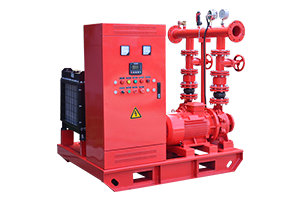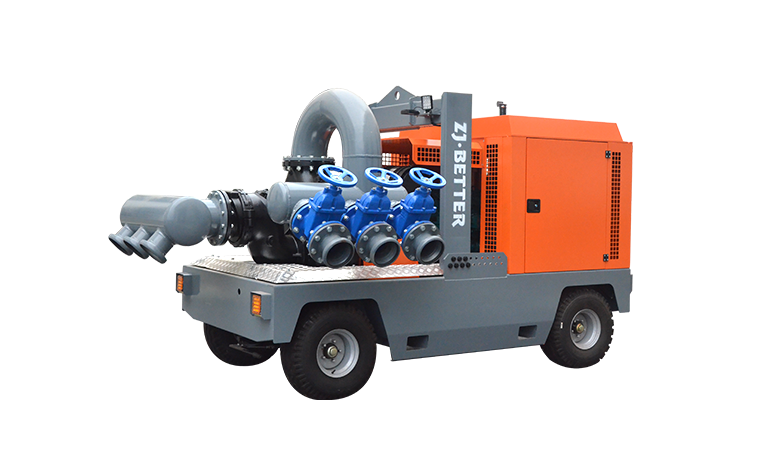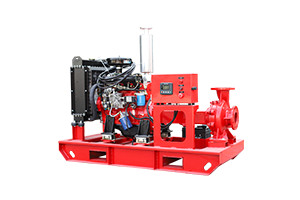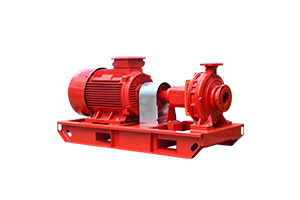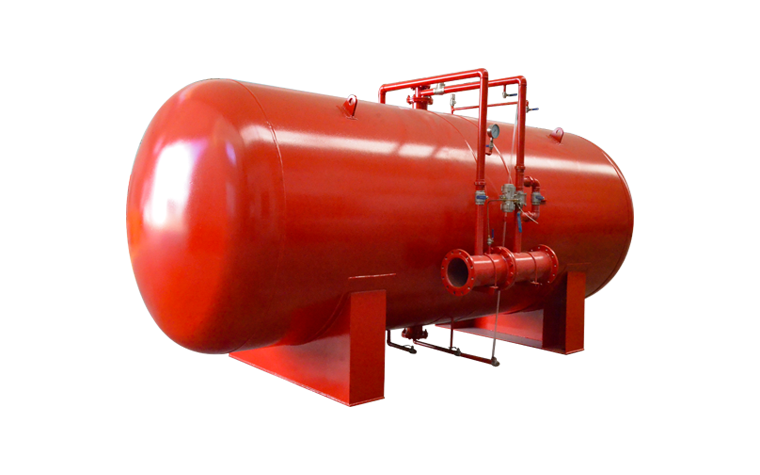-
 Jul 21, 2023Main structure of fire pump pressure gaugeA fire pump pressure gauge typically consists of the following main components:
Jul 21, 2023Main structure of fire pump pressure gaugeA fire pump pressure gauge typically consists of the following main components:
Gauge Casing: The casing serves as the outer protective housing for the pressure gauge. It is usually made of a durable material like stainless steel or brass to withstand harsh environmental conditions and potential impacts.
Dial Face: The dial face is the visible part of the pressure gauge that displays the pressure readings. It typically has a circular design with clear markings and numerical values to indicate the pressure in various units (e.g., PSI, kPa, bar).
Pointer: The pointer is attached to the center of the dial face and moves along the scale to indicate the current pressure value. It is connected to the internal mechanism and moves in response to changes in pressure.
Bourdon Tube: The Bourdon tube is a critical component inside the pressure gauge responsible for converting pressure into mechanical movement. It is usually made of a coiled tube that tends to straighten out when subjected to pressure changes. As the tube flexes, it translates the pressure-induced motion into the rotational movement of the pointer.
Movement Mechanism: The movement mechanism includes gears and levers that amplify the motion of the Bourdon tube and transfer it to the pointer. It ensures that the pointer accurately reflects the pressure being measured.
Calibration Adjustment: Some pressure gauges come with calibration adjustments to fine-tune the accuracy of the readings. This feature allows users to calibrate the gauge periodically to maintain precision.
Glass or Plastic Cover: The dial face is protected by a transparent cover made of glass or plastic to shield it from dust, moisture, and physical damage. The cover also allows users to read the pressure without direct contact with the gauge.
Mounting Bracket: Many pressure gauges have a mounting bracket or flange at the back for easy installation on the fire pump or the instrument panel.
Inlet Connection: The inlet connection is the port through which the pressure gauge is attached to the fire pump's pressure system. It typically has a threaded connection for secure attachment.
Fire pump pressure gauges are crucial for monitoring the pump's performance and ensuring it operates within safe and efficient pressure ranges. Regular inspection, calibration, and maintenance of the pressure gauge are essential to guarantee its accuracy and reliability during firefighting operations.
View details -
 Jul 21, 2023Design Principles of Centrifugal PumpsDesigning a centrifugal pump requires careful consideration of various engineering principles to ensure its optimal performance and efficiency. Below are some essential design principles for centrifugal pumps:
Jul 21, 2023Design Principles of Centrifugal PumpsDesigning a centrifugal pump requires careful consideration of various engineering principles to ensure its optimal performance and efficiency. Below are some essential design principles for centrifugal pumps:
Impeller Design: The impeller is the key component of a centrifugal pump responsible for generating the flow and pressure. Its design involves determining the number of blades, the blade shape, and the impeller diameter. The choice of impeller design affects the pump's efficiency, head, and flow characteristics.
Pump Casing: The pump casing is the outer enclosure that houses the impeller and directs the flow. Its design should promote smooth flow and minimize losses due to friction and turbulence. Casing geometry plays a significant role in optimizing pump efficiency.
Suction and Discharge Nozzles: Proper design of suction and discharge nozzles is critical to ensure smooth flow transitions, minimize recirculation, and avoid cavitation. These nozzles need to be sized appropriately to match the pump's flow rate and pressure requirements.
Shaft and Bearings: The pump shaft must be strong enough to withstand the rotational forces imparted by the impeller. Adequate support and lubrication of bearings are essential to reduce friction losses and ensure smooth rotation.
Sealing Mechanism: Centrifugal pumps need a sealing mechanism where the rotating shaft enters the pump casing. The design of this seal should prevent leakage and minimize wear between the rotating and stationary parts.
Efficiency and NPSH: Efficiency is a critical aspect of pump design. The pump should be optimized to operate at the best efficiency point (BEP). Moreover, Net Positive Suction Head (NPSH) is a crucial parameter to prevent cavitation, and the pump design should ensure that the NPSH requirements are met.
Materials Selection: The choice of materials for various pump components is essential to ensure compatibility with the pumped fluid, prevent corrosion, and extend the pump's lifespan.
Hydraulic Balancing: To reduce thrust loads and increase the pump's operational life, hydraulic balancing mechanisms can be incorporated in the design, such as balancing holes or back-to-back impellers.
Vibration and Noise: Design considerations should include minimizing vibration and noise levels to improve the pump's reliability and reduce the risk of mechanical failures.
Test and Validation: Prototypes of centrifugal pumps should be thoroughly tested under various conditions to validate their performance and efficiency. This process allows for adjustments and refinements to the design before final production.
Each of these principles plays a vital role in the performance, reliability, and longevity of a centrifugal pump. An integrated approach that considers all these factors is crucial for successful pump design and operation.
View details -
 Jul 20, 2023Fire pump knife gate valve, working principle of pneumatic actuatorA fire pump knife gate valve equipped with a pneumatic actuator combines the functionality of a knife gate valve with an actuator powered by compressed air. The pneumatic actuator is responsible for controlling the opening and closing of the valve using air pressure. Here's an overview of the working principle of a pneumatic actuator in a fire pump knife gate valve:
Jul 20, 2023Fire pump knife gate valve, working principle of pneumatic actuatorA fire pump knife gate valve equipped with a pneumatic actuator combines the functionality of a knife gate valve with an actuator powered by compressed air. The pneumatic actuator is responsible for controlling the opening and closing of the valve using air pressure. Here's an overview of the working principle of a pneumatic actuator in a fire pump knife gate valve:
Valve and Actuator Assembly: The knife gate valve is a type of isolation valve with a flat gate that slides in and out of the flow path. It is specifically designed for applications where a tight shut-off is required. The pneumatic actuator is mounted on top of the valve and is mechanically connected to the gate. The actuator consists of a housing, diaphragm or piston, spring, and air inlet/outlet ports.
Air Supply: The pneumatic actuator requires a supply of compressed air to operate. When air is supplied to the actuator through the air inlet port, it pressurizes the diaphragm or piston chamber inside the actuator housing.
Air Pressure Control: The air pressure inside the actuator can be controlled, allowing the operator to modulate the valve's opening and closing. By adjusting the air pressure, the actuator will move the gate of the knife gate valve to different positions within the flow path.
Opening the Valve: When the operator increases the air pressure inside the actuator, the diaphragm or piston will be forced upward, pulling the gate away from the flow path and opening the valve. The valve is fully open when the gate is retracted entirely into the actuator housing, allowing unrestricted flow through the valve.
Closing the Valve: To close the valve, the operator reduces the air pressure inside the actuator. The spring inside the actuator provides a closing force, pushing the diaphragm or piston downward. As the actuator compresses the spring, the gate slides back into the flow path, blocking the flow of water and effectively shutting off the valve.
Position Control: The pneumatic actuator can hold the valve gate at different positions within the flow path, allowing for partial opening or throttling of the valve as required for flow control.
Emergency Shutdown: In case of emergencies, such as power failure, the pneumatic actuator may have a fail-safe feature that allows for manual operation or automatic closing of the valve using a spring or other mechanical means.
Pneumatic actuators are commonly used in fire protection systems due to their reliability and quick response time. They offer precise control over the valve's operation and can be integrated into automated systems for remote operation and monitoring. Regular maintenance and testing are essential to ensure the pneumatic actuator and knife gate valve function correctly and are ready to respond to fire protection needs.
View details -
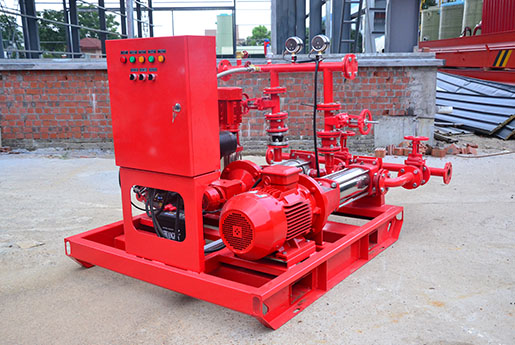 Jul 20, 2023Fire pump valve selection stepsSelecting the right fire pump valve is essential to ensure the effective operation of a fire protection system. Here are the steps you can follow to make the appropriate selection:
Jul 20, 2023Fire pump valve selection stepsSelecting the right fire pump valve is essential to ensure the effective operation of a fire protection system. Here are the steps you can follow to make the appropriate selection:
Determine system requirements: Understand the specific requirements of your fire protection system, including flow rate, pressure, and type of fire suppression system (e.g., sprinkler system, foam system).
Identify applicable standards and codes: Check local building codes, NFPA (National Fire Protection Association) standards, and any other relevant regulations to ensure compliance with safety and performance requirements.
Valve type selection: Based on the system requirements and applicable standards, choose the appropriate type of valve for your fire pump. Common types include:
a. Gate valves: These are typically used for on/off control and are often used as isolation valves to block water flow to specific sections of the system.
b. Butterfly valves: These provide efficient control over flow rates and are often used for modulating water flow.
c. Check valves: These valves allow water to flow in one direction only, preventing backflow and ensuring that water does not return to the pump.
d. Pressure relief valves: Used to protect the system from excessive pressure, ensuring the safety of both the pump and the connected components.
Material selection: Consider the materials used in the valve's construction, making sure they are compatible with the type of fire suppression system being used and can withstand the environment in which they will be installed (e.g., corrosive environments).
Size calculation: Determine the appropriate valve size based on the flow rate and pressure requirements of the fire protection system. Undersized valves may lead to inadequate water supply during firefighting, while oversized valves can be costly and inefficient.
Flow characteristics: Evaluate the flow characteristics of the valve, such as flow coefficient (Cv), pressure drop, and head loss. These factors can impact the overall performance of the fire protection system.
Actuation method: Decide on the valve actuation method, which can be manual, electric, pneumatic, or hydraulic. Consider the reliability and ease of operation for the selected method.
Manufacturer reputation and product quality: Research and choose a reputable valve manufacturer known for producing high-quality products and providing good customer support.
Installation and maintenance requirements: Ensure that the chosen valve is easy to install and maintain, and that spare parts are readily available when needed.
Consult with experts: If you are unsure about the selection process or have specific requirements, consider consulting with fire protection system designers, engineers, or valve experts to get professional advice.
By following these steps, you can select the most suitable fire pump valve for your fire protection system, ensuring optimal performance and compliance with safety standards.
View details -
 Jul 19, 2023Advantages of ordinary centrifugal pump automatic water supply deviceAn automatic water supply device using an ordinary centrifugal pump offers several advantages, making it a popular choice for various water supply applications. Some of the key advantages include:
Jul 19, 2023Advantages of ordinary centrifugal pump automatic water supply deviceAn automatic water supply device using an ordinary centrifugal pump offers several advantages, making it a popular choice for various water supply applications. Some of the key advantages include:
Continuous Water Supply: The automatic device ensures a continuous water supply without the need for manual intervention. It can detect when water levels drop below a certain point and activate the pump to replenish the water automatically.
Convenience: With an automatic water supply device, users don't have to manually start or stop the pump when the water level changes. This convenience is particularly beneficial in situations where a constant water supply is essential, such as in residential water systems or agricultural irrigation.
Energy Efficiency: Many automatic water supply devices are designed to be energy-efficient. They use sensors or switches to turn the pump on and off as needed, preventing unnecessary energy consumption when there is no demand for water.
Protection against Dry Running: Automatic devices often include dry run protection mechanisms. If the water source runs dry or if there's an issue with the pump, the device can shut off the pump to prevent damage from dry running, extending the pump's lifespan.
Pressure Regulation: Some automatic water supply devices incorporate pressure sensors or controllers to maintain consistent water pressure in the system. This feature is useful for applications requiring stable water pressure, such as in residential water distribution.
Space-saving: Integrating an automatic water supply device with a centrifugal pump eliminates the need for additional control equipment, resulting in a more compact and space-saving solution.
Reduced Water Wastage: By automatically monitoring water levels and usage, the device can optimize water supply and reduce wastage. This is especially important in applications where water resources are limited or expensive.
Remote Monitoring and Control: Some advanced automatic water supply devices can be integrated with smart systems, allowing remote monitoring and control through mobile applications or web interfaces. This feature provides users with real-time updates and control over their water supply system from anywhere.
Versatility: Automatic water supply devices can be used in various settings, such as homes, commercial buildings, farms, and industrial facilities. They are adaptable and can cater to different water supply requirements.
Reliability: When appropriately installed and maintained, automatic water supply devices with centrifugal pumps are reliable and can ensure a steady water supply for extended periods.
Overall, the automatic water supply device with an ordinary centrifugal pump offers convenience, energy efficiency, and protection against pump-related issues, making it a practical and reliable solution for water supply needs in various applications.
View details -
 Jul 19, 2023Causes of fire pump seal failureFire pump seal failure can have several causes, and it's crucial to address them promptly to ensure the pump's proper functioning and safety. Some of the common causes of fire pump seal failure include:
Jul 19, 2023Causes of fire pump seal failureFire pump seal failure can have several causes, and it's crucial to address them promptly to ensure the pump's proper functioning and safety. Some of the common causes of fire pump seal failure include:
Age and wear: Like any mechanical component, fire pump seals have a limited lifespan. Over time, they can become worn, brittle, and less effective at maintaining a proper seal, leading to failure.
Improper installation: Incorrect installation of the seal can lead to misalignment, excessive stress, or inadequate sealing. This may result in premature failure or reduced performance.
Contaminants: The presence of debris, dirt, or foreign particles in the pump's operating environment can damage the seal and cause it to fail prematurely.
Overheating: Fire pumps can generate significant heat during operation, and if the seal is not adequately designed to handle high temperatures or is subjected to thermal overload, it may fail.
Pressure fluctuations: Frequent pressure variations can put stress on the seal, causing it to degrade and ultimately fail.
Corrosion and chemical exposure: If the fire pump is exposed to corrosive chemicals or environments, the seal materials can deteriorate, leading to failure.
Shaft misalignment: Misalignment of the pump shaft can cause excessive wear on the seal, leading to leaks and failure.
Vibration and mechanical stress: Excessive vibration or mechanical stress on the pump can cause wear and tear on the seal, accelerating its failure.
Lack of maintenance: Insufficient or irregular maintenance of the fire pump can result in neglect of the seal's condition, leading to issues that may cause failure over time.
Material selection: Using incorrect or incompatible materials for the seal construction can lead to premature failure, especially if they cannot withstand the specific operating conditions.
Running dry: If the fire pump runs dry without adequate lubrication, the seal faces can overheat and wear out quickly.
To prevent fire pump seal failure, regular inspection, proper maintenance, and addressing any issues promptly are essential. Additionally, using high-quality seals designed for the specific application and operating conditions can significantly improve their longevity and performance.View details

